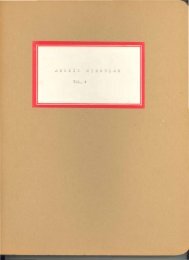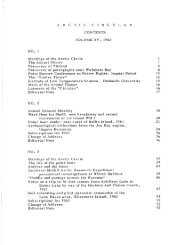Volume 11, 1958 - The Arctic Circle - Home
Volume 11, 1958 - The Arctic Circle - Home
Volume 11, 1958 - The Arctic Circle - Home
You also want an ePaper? Increase the reach of your titles
YUMPU automatically turns print PDFs into web optimized ePapers that Google loves.
VOL Xl No.2 THE ARCTIC CIRCULAR 18<br />
Physical type<br />
<strong>The</strong> physica.l type of the Eskimos is distinctive. Like all<br />
Mongoloid people they have straight black hair, dark brown eyes, high<br />
cheek bones, and wide faces. <strong>The</strong>ir skin is yellowish-brown but it is<br />
surprisingly light, lighter tha.n one would expect from their faces which<br />
are usually sunburnt from the sun on the snow and ice. <strong>The</strong> babies<br />
often have a distinct blue patch at the base of the spine which disappears<br />
after a year or two. <strong>The</strong> Eskimos have shorter arms and legs than the<br />
North American Indians and are therefore rather smaller in stature,<br />
but they are not in fact a short race by anthropological standards and<br />
they are as tall as people in many places in western Europe. <strong>The</strong>y are<br />
muscular and well covered and this, together with their bulky and<br />
loose-fitted clothes and rather short legs makes them appear to be stout,<br />
but this is a false impression. <strong>The</strong> ratio of skull breadth to length<br />
shows that they are mainly long-headed Or dolichocephalic, except in<br />
the south";cst, where the number of broad-headed Eskimos increases<br />
until in the Aleutians the population is as definitely broad-headed as the<br />
central Eskimos and Greenlanders are narrow-headed. <strong>The</strong> Eskimo<br />
skull is unmistakable to a physical anthropologist, and has a number of<br />
distinctive features which make it easy to recognize. As well as being<br />
long and narrow it is high and has a pronounced longitudinal ridge from<br />
front to back, and at the back there is a marked protrusion. <strong>The</strong> cranial<br />
capacity is large, and the nose is very narrow, narrower than in any<br />
other people. <strong>The</strong> cheek bones are high a,nd prominent and the face is<br />
wider than the skull itself and has a squarish shape. To white men all<br />
Eskimos seem to look the same at first, just as white men all look<br />
the same to the Es:dmos. <strong>The</strong>ir faces are really however very different<br />
and they range from the rounded cheerful face so often illustrated to the<br />
narrow, more dignified ova1.-shaped face with a well marked nose usually<br />
regarded as being North American Indian.<br />
<strong>The</strong> Eskimo culture<br />
<strong>The</strong> distinctive and remarkable Eskimo culture allows them to<br />
live under more extreme conditions than any other race. <strong>The</strong> typical form<br />
of the culture is the arctic form which is found among the majority of the<br />
Canadian Eskimos. Except in the summer it is an ice -hunting culture,<br />
based on hunting sea mammals either through the ice at their breathing<br />
holes, from the ice at the floc-edge, or on the ice when the seals lie<br />
enjoying the sunshine in the spring. <strong>The</strong> sea mammals provide the<br />
Eskimos with meat for food, coil for heat and light, and skins for many<br />
purposes. For this hunting the Eskimos have dogs and sledges and since<br />
there is little else to use in ~he way of building materials they live in<br />
snow houses.












